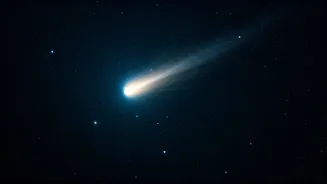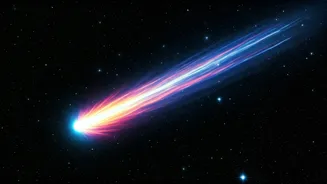What is ATLAS Comet?
The 3I/ATLAS comet, officially designated as an interstellar object, has captured the attention of scientists and space enthusiasts alike. This comet, unlike
those found within our solar system, originates from outside our galactic neighborhood. Its journey through the vast expanse of space makes it a rare and significant astronomical event. Such comets offer a unique chance to study the building blocks of other planetary systems and understand the composition of interstellar space. The comet's trajectory and behavior are carefully monitored, providing valuable data to astronomers worldwide. Its unique origin also raises interesting questions about how comets are formed and evolve throughout the universe. Furthermore, the 3I/ATLAS comet's presence near the sun offers a rare opportunity to study its characteristics up close, helping us to deepen our understanding of these cosmic wanderers.
Comet's Scientific Importance
The scientific value of studying the 3I/ATLAS comet is immense, providing insights into the formation and evolution of celestial bodies beyond our solar system. Analyzing the comet's composition, scientists can gather valuable information about the materials present in other star systems. This information is vital for understanding how planets and other celestial objects are formed. The comet's trajectory and speed offer clues about its interstellar origins, helping scientists to refine models of galactic dynamics. Furthermore, the observation of this comet could provide a better understanding of the interaction between interstellar objects and our solar system. Scientists use advanced telescopes and instruments to analyze the light reflected or emitted by the comet, which allows them to determine its chemical makeup. This in turn, provides data to compare and contrast with objects in our solar system, offering a more complete picture of the universe.
When and Where to View
To witness the 3I/ATLAS comet, keen observers need to know the optimal viewing times and locations. Given the comet's trajectory and visibility, specific dates and times are critical for spotting it. These details are often updated by astronomical organizations as they track the comet's movements. To get the best viewing experience, finding locations away from city lights is crucial. This helps to reduce light pollution, making the comet easier to see. Checking weather forecasts is also advised, as clear skies are necessary for observation. Furthermore, using binoculars or telescopes can enhance the viewing experience, allowing a closer look at the comet. Regular updates from astronomical sources can keep enthusiasts informed about the comet's movement and any changes in visibility. This will help them to plan their viewing sessions. The comet's visibility could depend on its brightness as it approaches the sun, so staying informed is the key.
Elon Musk's Warning
Elon Musk's comments on the 3I/ATLAS comet have generated widespread interest. His warnings, possibly reflecting concerns about the comet's unusual nature, have piqued the curiosity of both space enthusiasts and the general public. While specific details of his concerns may vary, his statements highlight the comet's uniqueness. Musk's warnings suggest that the 3I/ATLAS comet is not an ordinary celestial body. This has led to speculation about its composition, behavior, and potential impact. These warnings have encouraged people to do their own research, fostering a broader understanding of the event. While the exact motivations behind Musk’s statements are subject to interpretation, they have undoubtedly increased public awareness and interest in the comet and space exploration.
How to Watch Live
For those unable to observe the 3I/ATLAS comet directly, several options exist to watch the event live. Online platforms and observatories often provide live streams and real-time updates of astronomical events. These platforms broadcast the comet's progress using specialized telescopes and cameras, making it possible for anyone to watch. Many astronomy websites and social media channels provide comprehensive information, including viewing guides and expert commentary. Joining online astronomy communities can enhance the experience, allowing you to discuss and share observations. Furthermore, watching a live stream offers a chance to learn from experts and see the comet as it appears in real-time. This includes updates on the comet's location and any changes in its brightness. These online resources guarantee that enthusiasts worldwide can share in the excitement of witnessing this interstellar visitor.












